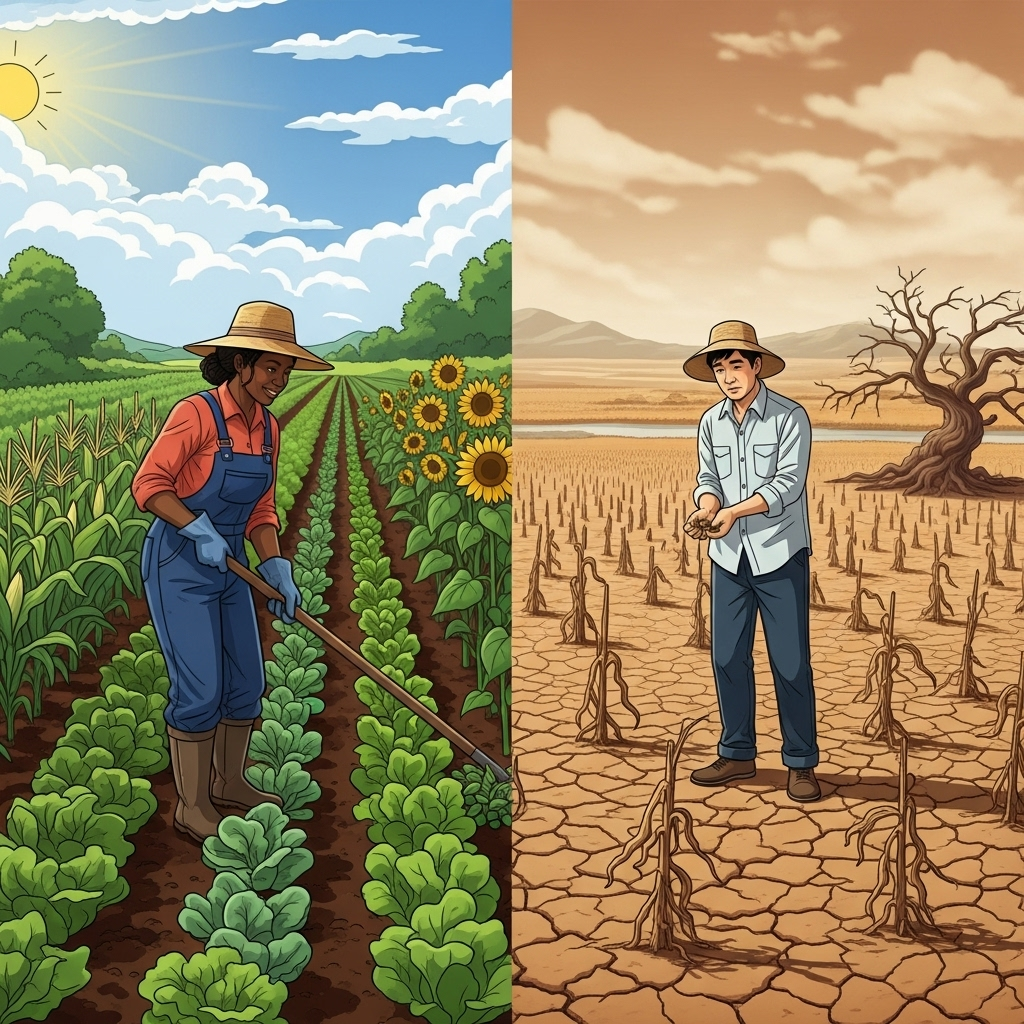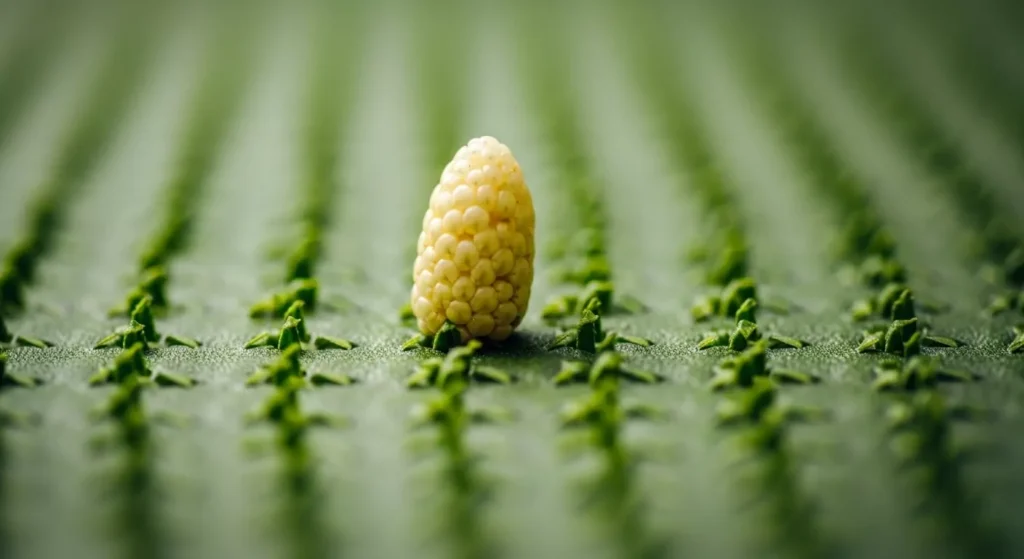Adapting to Changing Weather Conditions with Climate Smart Agriculture
Globally, the weather has become more unpredictable. Longer heatwaves, sudden rains, floods, and droughts are all becoming common features now. This climatic unpredictability translates into uncertain harvests, livelihoods, and risks for farmers. Based on research, the worldwide average yields of six staple crops, which comprise wheat, maize, rice, sorghum, cassava, and soybeans, can decline by over 12% by the end of this century due to a shifting climate, as farmers continue to battle to maintain production through traditional means.
Climate-smart agriculture is a corrective and strategic alternative, aimed at facilitating adaptation to change, focusing on resilience and being in harmony with nature. The strategy targets ensuring productivity, food security, and conservation of the environment.

What Does Climate Smart Agriculture Really Mean?
“Climate smart agriculture” is a term applied to describe agricultural practices that share three interrelated goals:
- Increase productivity in a way that makes it possible for farmers to produce sufficient food without degrading land or water.
- Boost resilience, so that agriculture can be made resilient to climate extremes, shocks, and changes in growth conditions.
- Cut emissions, in a bid to reduce greenhouse gases produced by agriculture, in its bid to fight climate change.
Climate-smart agriculture is not a standard approach. It harmonizes modern scientific tools, technology, indigenous knowledge, and governance to revolutionize agricultural practices. That is the approach that farmers and farmers’ groups in the developing world require if they are to cope with climate change in agriculture without guaranteeing that crops and animals can be sustained despite shifting weather conditions.
What are the main principles of climate smart agriculture?
Climate smart agriculture rests on four principles that reconcile productivity and protection of the environment.
- It is founded upon sustainability. Agriculture cannot be pursued at the expense of depleting natural resources. Crop rotation, conservation of soil, organic amendments, and biodiversity management ensure that the land remains fertile, water sources are preserved, and ecosystems remain intact for generations yet to be born. One can read our blog on sustainable farming practices to gain deeper insights.
- Resilience is equally critical. Climate smart agriculture knows that floods, droughts, heatwaves, pests, and diseases are no longer unusual shocks such as chronic stresses. Resilience involves taking up practices like drought-resistant seeds, agroforestry, and diversified cropping patterns that allow farms to absorb and recover quickly from these stresses.
- Efficiency refers to doing more with less. Precision irrigation, optimizing the use of fertilizers, and energy-efficient equipment save valuable resources like water, seeds, and power without compromising output. Farmers save money and reduce pollution of the environment.
- Finally, innovation gives rise to progress. Merging digital technologies, weather forecasting, solar energy, wind power systems, and improved crop genetics, while respecting heritage farmer data, forms a futuristic farming system.
Together, these principles make climate smart agriculture not only more productive but also more protective, more resilient, and more sustainable.
Smart Farming Methods: What Are They Suitable For During Weather Trends?
What are these really good methods that are working so well in climate smart agriculture to deal with altered weather? These good methods are being applied everywhere around the world today:
- Drought-resistant or heat-resistant varieties: Seeds developed that can survive longer periods of drought or heat.
- Optimal irrigation and water management: Drip irrigation, weather forecasts, and soil-moisture sensors direct water where and when needed.
- Planting trees among crop and livestock fields decreases farmers’ income diversification, sequesters carbon, shades the soil, and mulches the soil.
- Solar energy and windmills in farming: Use solar pumps and windmills, and biogas plants, to reduce fossil fuel usage and emissions.
- Conservation of soil fertility: Compost, rotation, cover crop, minimum tillage, conserve fertility and water irrespective of changing weather.
In fact, the new World Bank report indicated that through its agriculture and food projects until 2024, 4.7 million farmers were able to utilize improved agriculture technology, which is related to climate smart agriculture and projected to avoid CO₂ emissions of 174.5 million tons along the life-cycle.
How Does Climate Smart Agriculture Build Resilient Food Systems?
What does Climate Smart Agriculture look like in action? Here are some of the most effective smart farming techniques being adopted worldwide:
- By diversifying crops and using resilient crops, farmers reduce crop loss.
- Through soil and water conservation by means of sustainable agriculture, the productivity of yields over the long term is ensured.
- Through the provision of access to renewable energy and emissions reduction, the agricultural system enables climate mitigation, a two-way benefit for adaptation as well as the restraint of climate effects.
- Through ensuring rural economies’ stabilization through secure yields, farmer incomes become less risky.
These practices collectively build resilient food systems that are capable of supplying when the times get hard, with supply stability, and with the capacity to absorb shocks. Food that is secure in these systems means fewer market and community shocks with weather extremes.

What Are the Measurable Benefits of Climate Smart Agriculture?
The impact of Climate resilient agriculture extends beyond individual farms:
- Yield protection: Yield loss with climate change cannot be avoided to some extent, but the utilization of a resilient strategy would limit loss.
- Small environmental impact: Less water lost, less machinery and chemical emissions, more carbon stored in soils and trees.
- Food security and nutrition: Improved returns translate to communities with sufficient food, and adaptable systems equate to quality and accessibility.
- Economic stability: Climate smart farmers are economically more stable, experience lower disaster losses, and reduce input expenses.
Climate Smart Agriculture is thus both a climate change adaptation in farming strategy and a broader rural development model. It strengthens the future of farming by balancing productivity with responsibility.
Challenges in Scaling Climate Smart Agriculture
Despite the potentials that somehow make climate-resilient agriculture an option, few hindrances lurk in its embrace. The key issues faced by farmers and policymakers are:
- High capital expenses: Precise irrigation, climate-resistant seeds, soil sensors, and renewable power are typically capital-intensive technologies involving high initial investment. Under such circumstances, the majority of small and medium-scale farmers are not able to access them without support.
- Knowledge and capacity constraints: Mainly, smallholder farmers, the backbone of agriculture in many countries, may have no option of securing training, extension services, or demonstrations. And when such knowledge is missing, the very benefits of climate-resilient agriculture are denied them.
- Policy and Institutional Constraints: Agricultural policies and subsidies in various nations tend to support conventional and less durable approaches. This hinders innovation and retards adoption.
- Behavior and cultural inertia: Farming traditions are deep. Growers are reluctant to shift practices, fearing risks or having no evident proof that climate-smart agriculture will be lucrative.
Solutions:
- Financial assistance: Governments and global institutions provide subsidies, grants, or concessional loans that cut the upfront cost of technologies such as precision irrigation, improved seeds, and renewable energy.
- Training and extension services: Well-planned programmes to empower farmers with and to adopt climate-smart agriculture practices. Trust is built and knowledge shared through farmer cooperatives, demonstration farms, and agricultural universities.
- Policy reform: Guiding incentives and subsidies towards sustainable agriculture and climate-resilient agriculture encourages innovation and ensures resources are being invested in measures that boost long-term resilience.
Through combined efforts along financial, educational, and policy lines, climate-smart agriculture can be brought from vision to reality.
What Does the Future of Farming Look Like with Climate Smart Agriculture?
What if climate-smart agriculture goes to scale?
- Agriculture will be more robust, with improved risk management. Local weather warning systems, real-time monitoring, and climate-resilient production facilities in agriculture will restrain the devastating impacts of climate disruption.
- There will be stronger food systems. The weather will be less predictable, but such farms using climate-smart agriculture will still yield, steadying supply and price in markets.
- Climate and green objectives will be within reach. Reduced emissions, enhanced carbon sequestration, and better water and land regimes are appealing to international sustainability goals.
- There will be more innovation. With increasing numbers of farmers adopting bright farming methods, agri-innovation investment will start (public and private), leading to newer technologies.
How Can You Support or Adopt Climate Smart Agriculture?
Climate smart agriculture is not a choice; it is something we must do. With loss of yield, weather-driven assaults, and rising numbers hanging over us, we have no option but to transition to sustainable, resilient, and innovative approaches.
The following are actions readers, farmers, policymakers, and others can take:
- Learn: Begin by becoming familiar with climate smart agriculture. Investigate good sources such as the Food and Agriculture Organization (FAO) or learn more by visiting our blogs on agricultural innovation and the future of farming. Learning is the starting point for actual change.
- Adopt: Choose at least one or two practices suitable to your local conditions, such as drought-resistant seeds, precision irrigation, improving the health of soil, or renewable energy sources. Little changes pave the way for big ones.
- Advocate: Advocate for policies that encourage sustainable agriculture and climate resilient agriculture. As governments and institutions redirect subsidies and incentives, they pave the way for wider adoption.
- Share: Word travels through communities. Share what works for you, highlight success stories, and encourage others to do the same. Hands-on evidence will generate confidence much more than theory.
By collectively embracing climate smart agriculture, we secure productivity, protect ecosystems, and chart a sustainable future for both people and the planet.
